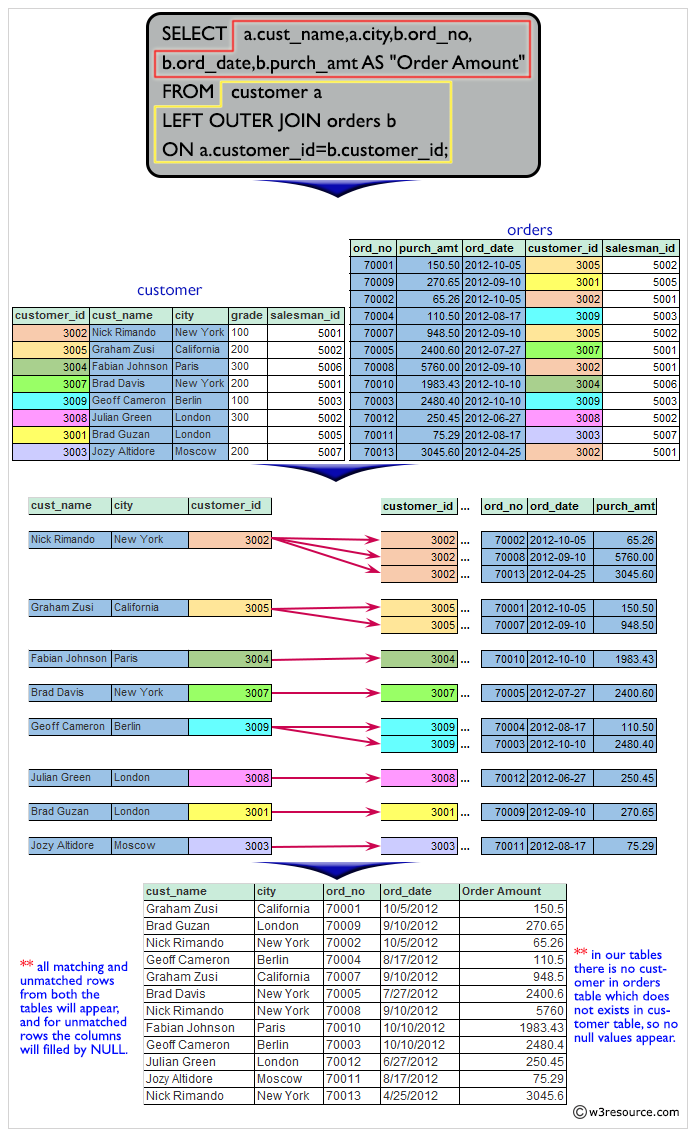SQL Exercise: One or more customers ordered from the existing list
15. Customer Order Placement Report
For those customers from the existing list who put one or more orders, or which orders have been placed by the customer who is not on the list, create a report containing the customer name, city, order number, order date, and purchase amount
Sample table: customer
customer_id | cust_name | city | grade | salesman_id
-------------+----------------+------------+-------+-------------
3002 | Nick Rimando | New York | 100 | 5001
3007 | Brad Davis | New York | 200 | 5001
3005 | Graham Zusi | California | 200 | 5002
3008 | Julian Green | London | 300 | 5002
3004 | Fabian Johnson | Paris | 300 | 5006
3009 | Geoff Cameron | Berlin | 100 | 5003
3003 | Jozy Altidor | Moscow | 200 | 5007
3001 | Brad Guzan | London | | 5005
Sample table: orders
ord_no purch_amt ord_date customer_id salesman_id ---------- ---------- ---------- ----------- ----------- 70001 150.5 2012-10-05 3005 5002 70009 270.65 2012-09-10 3001 5005 70002 65.26 2012-10-05 3002 5001 70004 110.5 2012-08-17 3009 5003 70007 948.5 2012-09-10 3005 5002 70005 2400.6 2012-07-27 3007 5001 70008 5760 2012-09-10 3002 5001 70010 1983.43 2012-10-10 3004 5006 70003 2480.4 2012-10-10 3009 5003 70012 250.45 2012-06-27 3008 5002 70011 75.29 2012-08-17 3003 5007 70013 3045.6 2012-04-25 3002 5001
Sample Solution:
-- Selecting specific columns and renaming one column for clarity
SELECT a.cust_name, a.city, b.ord_no,
b.ord_date, b.purch_amt AS "Order Amount"
-- Specifying the tables to retrieve data from ('customer' as 'a' and 'orders' as 'b')
FROM customer a
-- Performing a left outer join based on the customer_id, including unmatched rows from 'customer'
LEFT OUTER JOIN orders b
ON a.customer_id = b.customer_id;
Output of the Query:
cust_name city ord_no ord_date Order Amount Brad Guzan London 70009 2012-09-10 270.65 Nick Rimando New York 70002 2012-10-05 65.26 Geoff Cameron Berlin 70004 2012-08-17 110.50 Brad Davis New York 70005 2012-07-27 2400.60 Nick Rimando New York 70008 2012-09-10 5760.00 Fabian Johnson Paris 70010 2012-10-10 1983.43 Geoff Cameron Berlin 70003 2012-10-10 2480.40 Jozy Altidor Moscow 70011 2012-08-17 75.29 Nick Rimando New York 70013 2012-04-25 3045.60 Graham Zusi California 70001 2012-10-05 150.50 Graham Zusi California 70007 2012-09-10 948.50 Julian Green London 70012 2012-06-27 250.45
Explanation:
The said SQL query that is joining two tables: customer alias a, and orders alias b. The query is using a LEFT OUTER JOIN on customer and orders tables on the 'customer_id' column.
The query is then selecting several columns from each table: 'cust_name' and 'city' from 'customer' table, 'ord_no', 'ord_date', and 'purch_amt' aliased as 'Order Amount' from orders table.
The LEFT OUTER JOIN ensures that all rows from the customer table are included in the result set, with NULL values in the columns of the orders table for those customers that do not have any matching rows in the orders table.
Visual Explanation:
Go to:
PREV : Salesmen List with Order and Grade Criteria.
NEXT : Customer Order & Grade Report.
Practice Online
For more Practice: Solve these Related Problems:
- Write a SQL query to generate a report for customers who have placed one or more orders, displaying customer name, city, order number, order date, and purchase amount.
- Write a SQL query to list customers along with their order details, and include customers who have not placed any orders using a LEFT JOIN.
- Write a SQL query to produce a report showing all customers with orders, highlighting those who have orders placed through salesmen not on the existing list.
- Write a SQL query to display a comprehensive report of customer order placements, including both customers with and without orders, sorted by customer name.
Have another way to solve this solution? Contribute your code (and comments) through Disqus.
What is the difficulty level of this exercise?
Test your Programming skills with w3resource's quiz.

